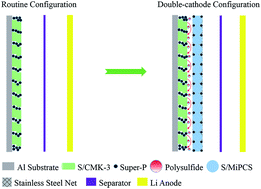Novel double-cathode configuration to improve the cycling stability of lithium–sulfur battery†
Abstract
Unsatisfactory cycling lifespan is a key problem hindering the practical applications of the next-generation lithium–sulfur batteries. Herein, we report a facile method to improve the cycling stability through a novel double-cathode configuration. In addition to the traditional cathode based on sulfur composite confined in mesoporous CMK-3 (denoted as S/CMK-3), an additional cathode based on sulfur composite confined in microporous carbon sphere (denoted as S/MiPCS) is set between the S/CMK-3 cathode and separator, which not only functions as a physical barrier to suppress polysulfides immigrating to the lithium anode but also contributes to the overall capacity with a moderate sulfur loading. The double-cathode cell (denoted as DCC) demonstrates a greatly improved cycling stability. After 50 cycles with deep discharge to 1 V at 0.5C, the DCC shows a capacity retention of 70%, whereas the single S/CMK-3 cathode only retains 28%. Even on replacing S/CMK-3 by pure S, the double cathode containing S/MiPCS still exhibits a remarkable improved cyclability. This impressive enhancement mainly benefits from the stable property of MiPCS and its “blocking and reutilization effect”. It can be visually confirmed that no polysulfides were generated upon the discharge process when sulfur is confined within the microporous carbon.


 Please wait while we load your content...
Please wait while we load your content...